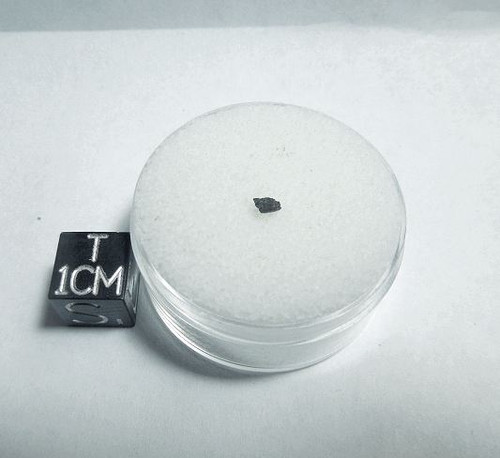Errachidia 004 is a new meteorite recovered from a newly-recognized DCA (dense collection area) in the Saharan Desert of Morocco. A group of stones were analyzed and classified as a winonaite achondrite. This meteorite has two distinct lithologies - one with low metal content and one with high metal content. It is thought that this type of winonaite may be a transitionary material between the winonaite class and silicate-rich iron meteorites. Less than 64 winonaites have been recovered worldwide and it remains one of the rarest classes of meteorites.
The specimens being offered here are small fragments of the high-metal lithology.
Refer to the photos. The black centimeter cube is shown for scale and is not included. You are purchasing a small fragment like the one shown. Your purchase will include a labeled gemjar for safe storage.
From the Meteoritical Bulletin entry on Errachidia 004 :
Errachidia 004 32°2.418’N, 4°4.092’W
Errachidia, Morocco
Find: 2020
Classification: Primitive achondrite (Winonaite)
History: Found in 2020 by Mustapha Oulkouch and other finders in a strewnfield centered within the isolated rural community of Oued Naam. Later purchased by Sean Mahoney in February 2020.
Physical characteristics: Many small stones and fragments covered with a weathered fusion crust. 75% of the stones contain low amounts of visible metal; the remaining 25% contain high amounts of visible metal.
Petrography: (D. Sheikh, FSU) This sample features two distinct lithologies: 1) A low-metal lithology (<10 vol% metal) displaying a predominantly granoblastic texture composed of forsterite, enstatite, augite, and sodic plagioclase (Silicate grain size Av. 110±50 µm) with the mineral grain boundaries meeting at approximately 120° triple junctions. Kamacite and troilite are finely scattered throughout the interior as either veinlets or individual grains; some have been altered to form Fe-oxides. No chondrules were observed. 2) A high-metal lithology (up to 80 vol% metal) displaying a well-developed Widmanstätten pattern containing kamacite, taenite, plessite, and accessory troilite and schreibersite (kamacite band width Av. 2 mm, range 1-3 mm), and containing angular silicate inclusions of sodic plagioclase (some containing melt inclusions), augite, and enstatite (Silicate grain size Av. 350±50 µm). No chondrules were observed.
Geochemistry: Low-metal lithology: Forsterite (Fa0.8±0.3, range Fa0.4-1.4, FeO/MnO=2±1, n=30), Enstatite (Fs4.3±0.6 Wo1.7±0.2, range Fs1.6-4.9 Wo0.8-2.0, FeO/MnO=4±1, n=22), Augite (Fs2.0±0.4 Wo45.0±1.0, range Fs1.2-2.6 Wo44.1-46.7, Na2O=0.7±0.2 wt%, Cr2O3=1.1±0.6 wt%, FeO/MnO=3±1, n=7), Sodic Plagioclase (An10.8±0.8 Or4.0±1.6, range An10.2-11.4 Or2.8-5.1); High-metal lithology: Sodic Plagioclase (An12.2±2.6 Or3.9±0.6, range An9.7-19.5 Or1.9-5.3), Augite (Fs2.4±0.3 Wo43.0±1.1, range Fs1.8-3.0 Wo39.9-45.7, Na2O=0.9±0.1 wt%, Cr2O3=1.5±0.1 wt%, FeO/MnO=3±1, n=19), Enstatite (Fs4.5±0.5 Wo1.8±0.3, range Fs3.9-5.7 Wo1.4-2.2, FeO/MnO=4±1, n=8). Oxygen isotopes (K. Ziegler, UNM): analyses of acid-washed subsamples by laser fluorination gave, respectively, Low-metal lithology: (δ17O 2.296, 3.022, 2.588; δ18O 5.276, 6.655, 5.843; Δ17O -0.489, -0.491, -0.497 per mil), High-metal lithology: (δ17O 3.940, 2.666, 2.577; δ18O 8.197, 6.019, 5.881; Δ17O -0.388, -0.512, -0.528 per mil). ICP-MS data of metal separates from high-metal lithology, using sample of North Chile (Filomena) as standard (C. Herd and P. Hill, UAb): Ni = 7.4, Co = 0.30 (both wt%); Ir = 5.9, Ga = 28, Ge = 123, As = 10.1, Ru = 5.0, Re = 0.5, Os = 13.6, Pt = 9.5, Cu = 180, Au = 0.85 (all μg/g).
Classification: Primitive achondrite (Winonaite). The unusual occurrence of two distinct lithologies within this sample suggests a transitional classification between an endmember winonaite (low-metal lithology) and a silicate-rich IAB-complex iron (high-metal lithology). This is supported by the oxygen isotopes, texture, and mineral abundances and compositions for both distinct lithologies, and the siderophile element abundances of metal separates from the high-metal lithology.





